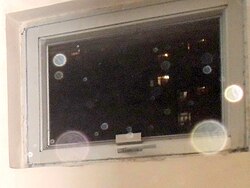
Back Orb (Fotografia) Catalan Geisterfleck German Φωτεινές σφαίρες Greek Orbs Spanish Orbe (photographie) French Hamburan balik ID Orb (fenomeno) Italian 玉響現象 Japanese Bebola cahaya (fotograf) Malay Lichtbol Dutch

In photography, backscatter (also called near-camera reflection[1]) is an optical phenomenon resulting in typically circular artifacts on an image, due to the camera's flash being reflected from unfocused motes of dust, water droplets, or other particles in the air or water. It is especially common with modern compact and ultra-compact digital cameras.[2][3]

Caused by the backscatter of light by unfocused particles, these artifacts are also sometimes called orbs, referring to a common paranormal claim. Some appear with trails, suggesting motion.[4]
- ^ Robinson, Edward M. (2016). Crime Scene Photography. Academic Press. p. 558. ISBN 978-0-12-802768-4.
- ^ "Flash reflections from floating dust particles". Fujifilm. Archived from the original on July 27, 2005. Retrieved 2017-06-19.
- ^ Baron, Cynthia (2008). Adobe Photoshop Forensics: Sleuths, Truths, and Fauxtography. Cengage Learning. p. 310. ISBN 978-1-59863-643-7.
- ^ Grimm, Tom; Grimm, Michelle (1997). The Basic Book of Photography. Plume (original from Pennsylvania State University). p. 509. ISBN 978-0452278257. Retrieved 2017-06-19.
An additional problem called backscatter occurs when flash light striking these suspended particles reflects back to the camera lens and records on the film as fuzzy white spots. Of course, backscatter can also be reduced by getting the camera as close to your subjects as possible, because the shorter that distance, the fewer the number of floating particles in front of the lens.